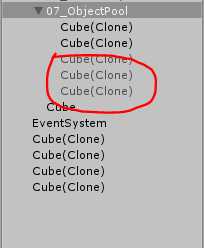标签:instant ack transform details obj 显示 init mono 实例化
我对对象池的简单理解:当一个游戏需要产生大量游戏物体又需要频繁销毁时,可用一个对象池将游戏物体存储起来。目的是优化内存。
以下两篇我参考过觉得OK的博文:
https://blog.csdn.net/u013236878/article/details/52443066
https://www.jianshu.com/p/6133fb7e0819
unity内简单实现一下:
1.canvas下新建空物体命名为07_ObjectPool,新建一个cube

2.创建一个脚本,内容如下,挂载在空物体上。
using System.Collections;
using System.Collections.Generic;
using UnityEngine;
/// <summary>
/// 对象池
/// </summary>
public class ObjectPool : MonoBehaviour {
//获取资源
public GameObject monster;
//怪物对象池
private Stack<GameObject> monsterPool;
//当前游戏世界里存在的或者说已经激活的怪物对象
private Stack<GameObject> activeMonsterList;
// Use this for initialization
void Start () {
monsterPool = new Stack<GameObject>();
activeMonsterList = new Stack<GameObject>();
}
// Update is called once per frame
void Update () {
if (Input.GetMouseButtonDown(0))
{
//如果我们需要游戏物体时我们要从池的管理内取
GameObject itemGo = GetMonster();
//做后续工作
itemGo.transform.position = Vector3.one;
activeMonsterList.Push(itemGo);
}else if (Input.GetMouseButtonDown(1))
{
if (activeMonsterList.Count > 0)
{
if (activeMonsterList.Count > 0)
{
//如果我们不适用或者销毁了当前怪物对象
//那么我们需要直接把怪物对象扔进池子
PushMonster(activeMonsterList.Pop());
}
}
}
}
private GameObject GetMonster()
{
GameObject monsterGo = null;
if (monsterPool.Count<=0) //如果池子里没有怪物对象
{
monsterGo = Instantiate(monster);
}
else //池子有怪物对象
{
monsterGo = monsterPool.Pop();
monsterGo.SetActive(true);
}
return monsterGo;
}
private void PushMonster(GameObject monsterGo)
{
monsterGo.transform.SetParent(transform);
monsterGo.SetActive(false); //令不使用的游戏对象失活
monsterPool.Push(monsterGo);
}
}
3.把创建的cube赋给monster对象,鼠标左键创建,右键销毁。可见右键销毁时并没有真正把物体销毁掉,而只是隐藏了起来,等到下一次左键创建新物体时再把隐藏的物体现实出来,这样就达到了节约内存的效果。只有当隐藏的对象全部都显示完毕但仍然在进行创建操作时,才会真正实例化一个物体。

末尾补充:对象池只需要一个,为此对象池应该被设计应用到一个安全的模式,所以要采用单例模式。我对单例模式的理解:类似于当前CPU只能运行一个进程,在运行这个的时候其他进程就不能抢占资源,补充一篇博文,里面讲解较为详细。(里面的模式代码粗略看了一下有点PV操作问题的感觉。。)
https://blog.csdn.net/jason0539/article/details/23297037
先发了有坑后面填
标签:instant ack transform details obj 显示 init mono 实例化
原文地址:https://www.cnblogs.com/LinawZ/p/12293533.html